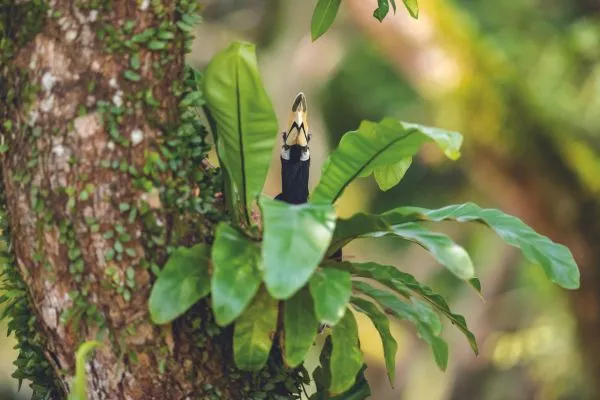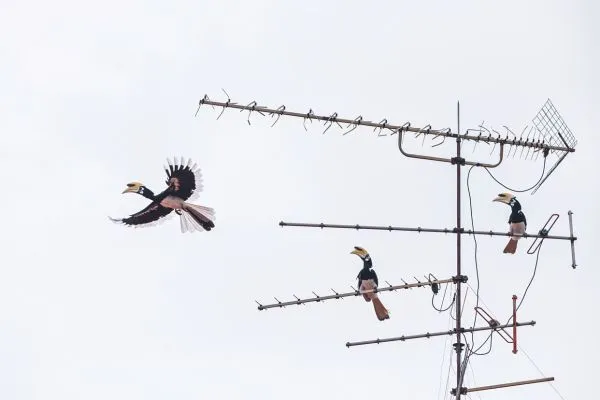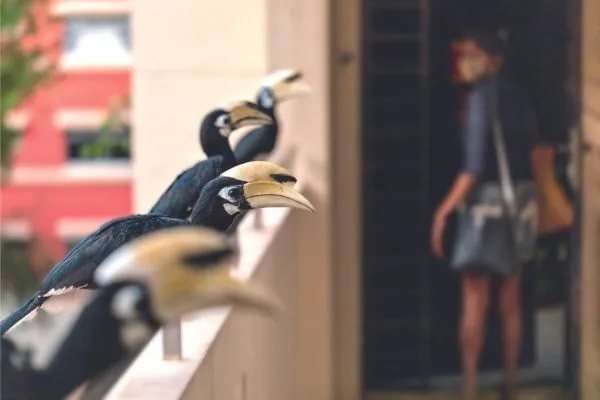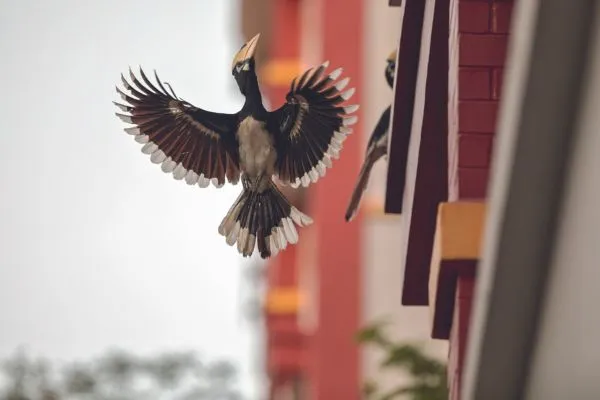Wildlife conservation film-maker and photographer, Tim Plowden, explores the return of the remarkable oriental pied hornbill.
Singapore has long had a reputation as one of the world’s greenest cities. Following independence from Malaysia almost 60 years ago, efforts began to transform this island nation into a ‘garden city’.

Today, as the world looks to nature as an ally in the climate crisis, it seems Singapore was way ahead of its time. Among the tightly packed high-rise apartments, office blocks and shopping malls, there are nature reserves, parks and buildings adorned with flowering trees and shrubs.
Greenery is everywhere in Singapore, bringing with it an abundance of wild creatures that have adapted to this very human landscape. Many are taken for granted, yet some of these urban species demonstrate remarkably innovative and intelligent behaviour that scientists are only just beginning to understand. One such example is the oriental pied hornbill.

This large bird, one of 62 hornbill species (and the only one in Singapore), is easily recognised by its long, downcurved bill and distinctive headgear called a casque. Unlike its cousins, which require large areas of forest to survive, the oriental pied hornbill is highly adaptable, able to carve out an existence in a variety of habitats, including mangroves, coastal scrub and urban settings.
The charismatic avian has had mixed fortunes in Singapore, declining to extinction by the early 1900s as a result of habitat loss and hunting. But by 1994, it was ready to stage a comeback. A pair began breeding on one of Singapore’s smaller islands, Pulau Ubin.
Until the 1970s, Ubin was home to a thriving granite industry, but its abandoned quarries have since been reclaimed by nature, and are now shrouded in secondary forest. As the vegetation returned, so did wildlife.
Scientists believe the intrepid hornbill pair came from neighbouring Malaysia. It is easy to imagine these large birds flying across the narrow channel between the two countries, less than a mile apart.
Hornbills nest in cavities made in large trees by other birds, such as woodpeckers. After entering her new abode, the female seals the cavity with a mixture of saliva and mud, leaving a small opening through which she can receive food supplied by the male.

It was this rather particular housing requirement that contributed to the species’ disappearance from Singapore from the late 19th century, as nesting trees were rapidly lost to pepper and gambier plantations.
“Oriental pied hornbills occasionally visited Singapore from neighbouring countries, but couldn’t remain to breed as there was a shortage of big, old trees with natural cavities,” says Lim Liang Jim from the National Parks Board.
The breeding efforts of that returning pair were given a helping hand by members of the Singapore Hornbill Project, which launched in 2006. By then, the Ubin hornbill population had increased steadily on its own, reaching 15 individuals, and seven artificial nest boxes placed across the island provided a further boost. All were occupied by at least one pair each, and more than 50 nestlings have been recorded in the years since.

Nest boxes were also put up in other parts of Singapore, and in 2008 the project released a pair of captive-bred hornbills into Bukit Timah Nature Reserve, which shelters one of the country’s last remnants of primary rainforest. A further three releases were spread across other areas, including Ubin, to diversify the gene pool.
While this support has aided the species’ recovery, it’s no surprise that Singapore’s continued greening efforts have also benefitted the birds. “The planting of native trees has enhanced the habitat for oriental pied hornbills and enabled the species to thrive,” says Jim. “In larger landscapes, the oriental pied hornbill is typically found in disturbed forests and forest edges, as well as along the coasts, so parks and urban spaces are great habitat for them. Thanks to sustained efforts over the years, these birds are no longer a rare sight in Singapore.”
Ubin remains the species’ stronghold, with a population of approximately 50 birds, but its presence on the mainland has been growing. When I moved into a neighbourhood beside a park on the east coast in 2017, I regularly encountered flocks of more than a dozen hornbills, and these characterful creatures became part of my daily life. Cycling along the regular route between their daytime foraging haunts and roosting site, I’d often be accompanied by flocks gliding above me on outstretched wings. In the playground with our daughter, the birds would sometimes emerge from the surrounding canopy to join in the fun, chasing each other from the trees to the swings and seesaws, where they’d perch and fence using their bills. They would even dust-bathe and preen in the sandpit, surrounded by captivated children.
You invariably hear hornbills before you see them, as their loud, cackling call carries for at least a mile. The male is the most vocal, but the uproarious duet when a pair comes together is rivalled by few other birds.
Another evocative sound of the hornbill is the unmistakable beat of its wings as it flies overhead on its foraging rounds, gracefully swooping from tree to tree on the hunt for food. The oriental pied hornbill is omnivorous, so its diet is varied. Fruit, insects and lizards are the mainstay, with grubs and small geckos favourite snacks.
While the birds still make regular forays to feeding grounds in the mangroves or areas of forest, this highly adaptive species has also learned to take advantage of the feeding opportunities that come with life among humans. Whether out of curiosity or opportunism, the birds can’t resist poking their heads inside litter bins, and I’ve even seen individuals feeding on rice left out for feral dogs.

There is also another particularly coveted, less accessible item on the menu, which these intelligent birds have very clever ways of acquiring – something I witnessed for myself in 2019. That spring, a pair of black-naped orioles – a striking black-and-yellow bird – started to build a nest in the umbrella tree behind my apartment. Within a week, a male hornbill arrived on the scene, inspecting the abode while the orioles were busy collecting materials.
He returned four days later, as if to check on progress, and came back again, accompanied by a female, a week after that. Despite the significant size difference, the orioles chased the intruders away and proceeded to lay their eggs.
Not to be outdone, the hornbills came back a week later, their rank now boosted with another male. Outnumbered and outwitted, the orioles could only look on as the first male hornbill extracted two eggs from the nest. Using the tips of his mandibles as pincers so as not to damage his prize, he tossed each egg up in the air and caught it at the back of his throat, ready to regurgitate to his own fledglings.
What was most remarkable about this encounter was the way this male was able to recruit members of his flock and coordinate a series of predation attempts. This behaviour exemplifies the intelligence of these ‘brainiacs of the jungle’, an asset from birth. “Hornbill chicks spend a long time with their mothers inside the nest hole,” explains Anuj Jain from BirdLife International Asia. “Most animals that have a long gestation and fledging period are intelligent – in producing few progeny, parents are able to invest in care.”
Watch Tim Plowden's film, The Circle of Life, about nest predation by Oriental Pied Hornbills in Singapore.
But that’s not all. According to Jain, oriental pied hornbills also mature slowly and live longer than most other birds. And while not as gregarious as parrots, they live in groups and have well developed vocalisations to communicate with each other, equipping them well for city living. Around 6pm each day, beside a housing estate that borders a coastal park, rush-hour traffic crawls across a bridge.

But it’s not just people returning home from a hard day’s work. Members of a hornbill flock have had a busy day, too, spending the morning foraging in the mangrove downriver, resting and preening in park trees during the sweltering heat of midday, and feeding in trees along the coast in the afternoon.
They gather on streetlamps lining the bridge before gliding one by one into their roost – a canopy of tamarind trees among the human dwellings. The hornbills arrive as the aroma of fragrant spices fills the air, their exuberant chatter accompanying the sound of dinner cooking. As people embark on exercise routines along the tree-lined river, above the canopy, perched on high-rise balconies, a dozen hornbills play games of chase and interlock their bills as they spiral downwards, as if enjoying one final fling before bedtime.
In the past, they would wait for handouts of tropical fruit but such offerings are no more – bird feeding in this neighbourhood was outlawed in 2020 and now carries fines of up to S$5,000. There was a worry that handfeeding, even if out of concern for the hornbills’ diminished food supply, could make the birds victims of their own success. “People believed they were helping, or that feeding the birds is good karma,” says Jain, “but it would be dangerous for them to become over-habituated to humans. They are large birds with long, pointed beaks and could act aggressively if threatened.”

Now, when nesting activity is observed in trees, the National Parks Board cordons off the area. It’s all about learning ways to coexist. I feel positive about the future of these birds in Singapore, as they continue to thrive in their city surroundings. “The younger generation is standing up for nature conservation, far more than 10 or 20 years ago,” says Jain. “I hope these special birds are forever part of the cityscape.”
How Singapore is transforming its skyrises
Skyrise greenery refers to the integration of plants and greenery into buildings and urban structures. It can take many forms, including rooftop gardens, green walls, living facades and atriums. Many cities, including Singapore, are promoting skyrise greenery to create green spaces in dense urban areas and to help mitigate the urban heat-island effect.
The Singapore government has implemented policies to encourage skyrise greenery, such as offering tax breaks and financial incentives to developers that incorporate greenery into their buildings. By creating green spaces on buildings, cities can provide habitat for birds, butterflies and other pollinators, which support biodiversity and improve air quality. Maintenance, though, is expensive. “We have to do more in terms of creating wilder landscapes that are native, easier to maintain and support a wider biodiversity,” says Anuj Jain of BirdLife International Asia.
About the author
Tim Plowden is a wildlife conservation film-maker and photographer. He spent the past 10 years in South-East Asia, specialising in documenting the wildlife trade and urban wildlife.
Want to find out more?
Check out our expert guide to hornbills, and read the answers to questions like do birds have knees? Why do they look weird? and find out what are the smallest birds in the world: discover 10 tiny avian wonders.